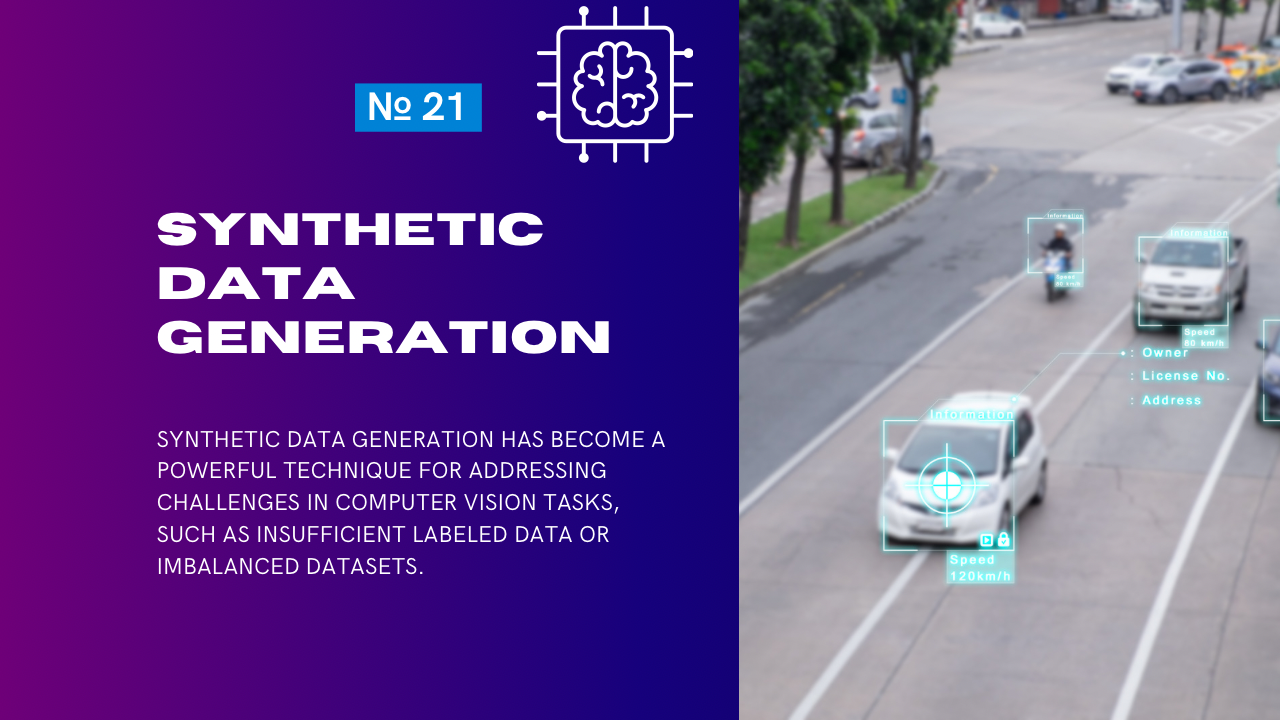Synthetic data generation has become a powerful technique for addressing challenges in computer vision tasks, such as insufficient labeled data or imbalanced datasets. Tools like Unity and Blender enable the creation of highly customizable, realistic, and diverse synthetic datasets for training machine learning models.
Why Use Synthetic Data for Computer Vision?
- Cost Efficiency: Generating synthetic data is often cheaper than manually labeling large datasets.
- Customizability: Allows control over lighting, camera angles, textures, and object variations.
- Solves Data Imbalances: Easily create balanced datasets by augmenting underrepresented classes.
- Edge Cases: Generate rare or edge-case scenarios that are difficult to capture in real-world data.
- Privacy: Avoids privacy concerns associated with real-world data.
Key Use Cases
| Use Case | Description |
|---|---|
| Object Detection | Generate images with labeled bounding boxes for objects in various environments. |
| Instance Segmentation | Create pixel-perfect masks for each object instance. |
| 3D Pose Estimation | Simulate 3D object poses for robotics or AR applications. |
| Autonomous Driving | Simulate traffic scenarios with vehicles, pedestrians, and varying weather conditions. |
| Robotics | Generate training data for robotic manipulation in controlled environments. |
Tools for Synthetic Data Generation
1. Unity
Unity, a real-time 3D engine, is widely used for synthetic data generation due to its high-quality rendering and physics simulation capabilities.
Key Features:
- Customizable Scenes: Create and manipulate environments with realistic lighting, materials, and textures.
- Scripting Support: Automate data generation with C# scripts or Unity’s Python API.
- Unity Perception Package: A tool specifically designed for synthetic data generation, providing built-in sensors, randomization, and labeling.
Steps to Use Unity for Synthetic Data:
- Set Up Unity Perception Package:
- Install Unity Hub and create a new project using the 3D (Core) template.
- Add the Unity Perception Package via the Unity Package Manager.
- Create a Synthetic Data Scene:
- Import 3D models of objects or environments.
- Configure cameras and lights for realistic rendering.
- Add prefabs for objects to be detected or segmented.
- Define Randomization:
- Use the Perception Package to randomize object positions, textures, lighting, and camera angles.
- Example of randomizing object placement:
using UnityEngine.Perception.Randomization.Randomizers; public class ObjectRandomizer : Randomizer { protected override void OnIterationStart() { foreach (var obj in objectsToRandomize) { obj.transform.position = Random.insideUnitSphere * randomRange; } } }
- Export Data:
- Capture images with bounding boxes, segmentation masks, or keypoints.
- Save data in a COCO-compatible format for model training.
2. Blender
Blender is an open-source 3D modeling and animation tool that provides advanced features for generating synthetic data.
Key Features:
- High-Quality Rendering: Supports ray tracing for photorealistic images.
- Python API: Automate object placement, rendering, and annotations.
- Physics Simulation: Simulate realistic object interactions and deformations.
Steps to Use Blender for Synthetic Data:
- Set Up the Environment:
- Install Blender and set up the scene by importing 3D assets.
- Configure the camera and lighting for optimal rendering.
- Automate with Python:
- Use Blender’s Python API to randomize object properties and automate rendering.
- Example script for object randomization:
import bpy import random # Randomize object positions for obj in bpy.data.objects: if obj.name.startswith("Object"): obj.location.x = random.uniform(-5, 5) obj.location.y = random.uniform(-5, 5) obj.location.z = random.uniform(0, 5) # Render and save the image bpy.context.scene.render.filepath = "/path/to/output/image.png" bpy.ops.render.render(write_still=True)
- Generate Annotations:
- Use Blender’s Python API to extract bounding boxes, segmentation masks, and 3D keypoints.
- Save annotations in standard formats like COCO or Pascal VOC.
- Batch Rendering:
- Automate the generation of thousands of images with randomized settings using Blender’s headless mode:
bash blender -b scene.blend -P script.py
Comparison: Unity vs. Blender
| Aspect | Unity | Blender |
|---|---|---|
| Ease of Use | User-friendly for developers familiar with game engines. | Steeper learning curve for newcomers. |
| Scripting Language | C# (built-in) and Python API. | Python API for automation. |
| Rendering Quality | High-quality real-time rendering. | Photorealistic ray tracing (better for realism). |
| Simulation Capabilities | Advanced physics for dynamic object interactions. | Excellent for complex animations and deformations. |
| Ideal Use Case | Real-time applications like robotics and autonomous driving. | High-detail scenarios, such as product rendering. |
Example Use Case: Object Detection Dataset
Scenario:
Generate a dataset of objects (e.g., chairs and tables) in a random environment for object detection.
Steps with Unity:
- Create a 3D room environment and add 3D models of chairs and tables.
- Use the Unity Perception Package to:
- Randomize object positions, textures, and lighting.
- Configure the camera to capture images at various angles.
- Automatically generate bounding box annotations.
- Export the dataset in COCO format.
Steps with Blender:
- Import 3D models of chairs and tables into Blender.
- Use a Python script to:
- Randomize the placement and orientation of objects.
- Render images and extract bounding boxes using Blender’s API.
- Export annotations to JSON.
Integration with ML Pipelines
- Data Storage:
- Store generated datasets in cloud storage (e.g., AWS S3, Google Cloud Storage).
- Data Augmentation:
- Apply further augmentations (e.g., rotation, scaling) during model training.
- Model Training:
- Train object detection or segmentation models using frameworks like PyTorch or TensorFlow.
- Validation:
- Test models on real-world datasets to ensure generalizability.
Challenges of Synthetic Data
| Challenge | Solution |
|---|---|
| Domain Gap | Models trained on synthetic data may not generalize well to real-world data. |
| Overfitting to Rendered Artifacts | Use domain randomization to add noise, blur, and imperfections in synthetic data. |
| Computational Costs | Rendering high-quality images can be resource-intensive; use cloud-based rendering services. |
Conclusion
Both Unity and Blender are excellent tools for generating synthetic datasets for computer vision tasks. Unity excels in real-time, dynamic environments, while Blender is ideal for high-quality, photorealistic rendering. By leveraging these tools, you can create diverse, scalable datasets to boost model performance and address real-world challenges.
